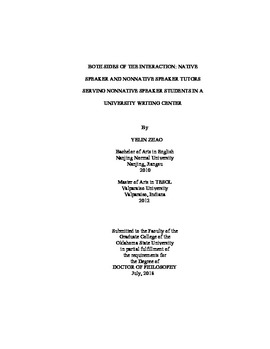| dc.contributor.advisor | Moder, Carol Lynn | |
| dc.contributor.author | Zhao, Yelin | |
| dc.date.accessioned | 2019-07-19T14:33:29Z | |
| dc.date.available | 2019-07-19T14:33:29Z | |
| dc.date.issued | 2018-07-01 | |
| dc.identifier.uri | https://hdl.handle.net/11244/320977 | |
| dc.description.abstract | This dissertation includes three studies that investigate: 1) the interactions of native speaker (NS) tutors and nonnative speaker (NNS) tutors with NNS students in a university writing center (WC), 2) NNS students' perceptions of NNS and NS tutors, and 3) the effects of tutorial interactions on student learning. Most WC studies have been written with the assumption that all tutors are NSs. Study 1 aims to fill this gap. I used conversation analysis to detail how the same NNS student interacted with one NS tutor and one NNS tutor. Retrospective interviews were conducted to explore the student's opinions of these tutorials. The analysis of the tutorials reveals that the NS tutor's adoption of recasts at the outset was aligned with the student's ends to have her paper proofread, and the NNS tutor's use of a Zone of Proximal Development (ZPD) approach was not welcomed by the student. Interview data shows that indeed the NNS student preferred the NS over the NNS tutor. However, the student stated that tutors' NNS/NS status, but not their approaches, contributed mostly to her preference. Study 2 aims to further examine NNS students' perceptions of NNS and NS tutors. This study adopted matched guise experiments and found that despite the fact that content of the tutorial was identical in both cases, students shown a photo of a Chinese NNS tutor assigned more negative ratings than students shown a photo of an American NS tutor did. NNS students' biases notwithstanding, studies investigating the effect of tutoring on their longer term learning are few. Study 3 aims to fill this gap. Performing conversation analysis and post-tutorial tests, Study 3 found that typical feedback strategies used by NS tutors followed by NNS students' minimal responses did not lead to much demonstrable learner acquisition. In contrast, ZPD and dynamic assessment (DA) approaches followed by students' active participation provided more evidence of longer term acquisition. The findings of this dissertation highlight the power of ZPD and DA as effective approaches for facilitating NNS students' acquisition in one-to-one tutorials. These approaches should be taken seriously by WC scholars. | |
| dc.format | application/pdf | |
| dc.language | en_US | |
| dc.rights | Copyright is held by the author who has granted the Oklahoma State University Library the non-exclusive right to share this material in its institutional repository. Contact Digital Library Services at lib-dls@okstate.edu or 405-744-9161 for the permission policy on the use, reproduction or distribution of this material. | |
| dc.title | Both Sides of the Interaction: Native Speaker and Nonnative Speaker Tutors Serving Nonnative Speaker Students in a University Writing Center | |
| dc.contributor.committeeMember | Cheng, An | |
| dc.contributor.committeeMember | Sicari, Anna | |
| dc.contributor.committeeMember | Kennison, Shelia M. | |
| osu.filename | Zhao_okstate_0664D_15934.pdf | |
| osu.accesstype | Open Access | |
| dc.description.department | English | |
| dc.type.genre | Dissertation | |
| dc.type.material | Text | |
